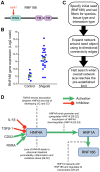Deep resequencing of GWAS loci identifies rare variants in CARD9, IL23R and RNF186 that are associated with ulcerative colitis
- PMID: 24068945
- PMCID: PMC3772057
- DOI: 10.1371/journal.pgen.1003723
Deep resequencing of GWAS loci identifies rare variants in CARD9, IL23R and RNF186 that are associated with ulcerative colitis
Abstract
Genome-wide association studies and follow-up meta-analyses in Crohn's disease (CD) and ulcerative colitis (UC) have recently identified 163 disease-associated loci that meet genome-wide significance for these two inflammatory bowel diseases (IBD). These discoveries have already had a tremendous impact on our understanding of the genetic architecture of these diseases and have directed functional studies that have revealed some of the biological functions that are important to IBD (e.g. autophagy). Nonetheless, these loci can only explain a small proportion of disease variance (~14% in CD and 7.5% in UC), suggesting that not only are additional loci to be found but that the known loci may contain high effect rare risk variants that have gone undetected by GWAS. To test this, we have used a targeted sequencing approach in 200 UC cases and 150 healthy controls (HC), all of French Canadian descent, to study 55 genes in regions associated with UC. We performed follow-up genotyping of 42 rare non-synonymous variants in independent case-control cohorts (totaling 14,435 UC cases and 20,204 HC). Our results confirmed significant association to rare non-synonymous coding variants in both IL23R and CARD9, previously identified from sequencing of CD loci, as well as identified a novel association in RNF186. With the exception of CARD9 (OR = 0.39), the rare non-synonymous variants identified were of moderate effect (OR = 1.49 for RNF186 and OR = 0.79 for IL23R). RNF186 encodes a protein with a RING domain having predicted E3 ubiquitin-protein ligase activity and two transmembrane domains. Importantly, the disease-coding variant is located in the ubiquitin ligase domain. Finally, our results suggest that rare variants in genes identified by genome-wide association in UC are unlikely to contribute significantly to the overall variance for the disease. Rather, these are expected to help focus functional studies of the corresponding disease loci.
Conflict of interest statement
The authors have declared that no competing interests exist.
Figures

References
-
- Xavier RJ, Podolsky DK (2007) Unravelling the pathogenesis of inflammatory bowel disease. Nature 448: 427–434. - PubMed
Publication types
MeSH terms
Substances
Grants and funding
- R01 CA141743/CA/NCI NIH HHS/United States
- UL1 TR000005/TR/NCATS NIH HHS/United States
- P30 DK043351/DK/NIDDK NIH HHS/United States
- U24 DK062429/DK/NIDDK NIH HHS/United States
- DK064869/DK/NIDDK NIH HHS/United States
- DK062423/DK/NIDDK NIH HHS/United States
- U01 DK062432/DK/NIDDK NIH HHS/United States
- R01 DK064869/DK/NIDDK NIH HHS/United States
- U01 DK062429/DK/NIDDK NIH HHS/United States
- U01 DK062422/DK/NIDDK NIH HHS/United States
- ETM/137/CSO_/Chief Scientist Office/United Kingdom
- DK062420/DK/NIDDK NIH HHS/United States
- DK062429/DK/NIDDK NIH HHS/United States
- P01 DK046763/DK/NIDDK NIH HHS/United States
- G0600329/MRC_/Medical Research Council/United Kingdom
- DK062422/DK/NIDDK NIH HHS/United States
- U01 DK062413/DK/NIDDK NIH HHS/United States
- G0800759/MRC_/Medical Research Council/United Kingdom
- ETM/75/CSO_/Chief Scientist Office/United Kingdom
- CZB/4/540/CSO_/Chief Scientist Office/United Kingdom
- DK062431/DK/NIDDK NIH HHS/United States
- WT_/Wellcome Trust/United Kingdom
- U01 DK062423/DK/NIDDK NIH HHS/United States
- UL1 TR000077/TR/NCATS NIH HHS/United States
- G0800675/MRC_/Medical Research Council/United Kingdom
- DK062432/DK/NIDDK NIH HHS/United States
- DK062413/DK/NIDDK NIH HHS/United States
- U01 DK062420/DK/NIDDK NIH HHS/United States
- GPG-102170/CAPMC/ CIHR/Canada
- U01 DK062431/DK/NIDDK NIH HHS/United States
LinkOut - more resources
Full Text Sources
Other Literature Sources
Medical
Molecular Biology Databases

